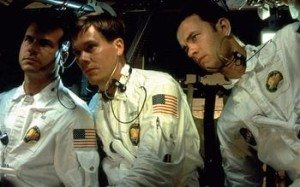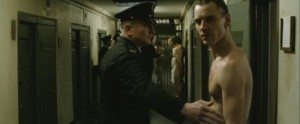There was one shot in Steve McQueen’s 12 Years a Slave that made it all clear for me. A slave stands below the sweep of a tree, he lifts a dented horn to his mouth, and he forces a call through the mist. Because of the dappling of the light and shallowness of the focus, this moment appears pointillist. The suggestion of man instead of a study of him.
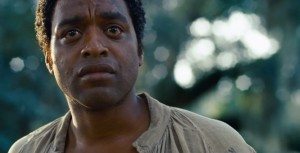 A day later, I could not tell you who the man was or why he sounded the horn. Was it Chiwetel Ejiofor in his lead role as Solomon Northrup? I don’t remember. I only recall, in that moment, how it felt to see that man unclearly.
A day later, I could not tell you who the man was or why he sounded the horn. Was it Chiwetel Ejiofor in his lead role as Solomon Northrup? I don’t remember. I only recall, in that moment, how it felt to see that man unclearly.
The lack of information was moving.
This is relevant not only to 12 Years a Slave, but also to Ender’s Game, and the other films that passed in front of me this weekend: Lady in the Water and Apollo 13. It’s an issue I’ve been thinking about since I watched last year’s The Hobbit: An Unexpected Journey in 48 frames-per-second, a film which violently jammed information into me like my brain was the cavity of a turkey.
There are two pieces to this puzzle and their relationship is only suggestive. The first piece is about how a film is presented visually — whether literal clarity is always a filmmaker’s friend. The second piece is about narrative structure — whether clarity of plot and character makes films more comprehensible at the expense of engagement.
Lady in the Water is a bad example
When I look at the world, it almost always lacks focus. We all see the world through smog and dust and bent light. We have our ideas and our imaginations and they are the lenses through which we perceive everything — particularly when we are forced, by a lack of hard data, to engage emotionally and intellectually.
Right now, we are in a world where pretty much everything a person wants to know is made accessible. This is not making us smarter. It is making us hollow. Where before we might have learned things or attempted to deduce answers, now we just look them up.
In the context of cinema and television technology, we are being tempted with this surplus of data, and being told that it is an improvement. This is not true. Bonus features and extended cuts are signs of weakness, not strength.
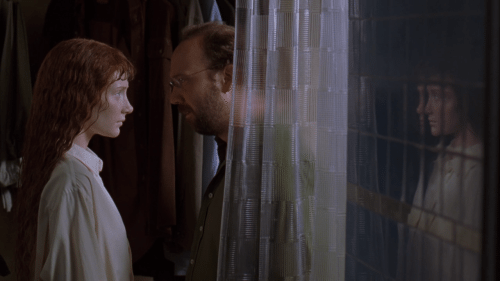 When I sat down to watch M. Night Shyamalan’s Lady in the Water on Saturday night, I did not expect it to be good. On the contrary, I was watching it precisely because I had heard it was astoundingly terrible.
When I sat down to watch M. Night Shyamalan’s Lady in the Water on Saturday night, I did not expect it to be good. On the contrary, I was watching it precisely because I had heard it was astoundingly terrible.
That was an understatement.
From its first animated scenes describing some incomprehensibly stupid hodge-podge mythology to its climactic battle with computer-generated grass wolves (called scrunts), I was hard pressed to find anything in the film that wasn’t ghastly. The film evolved as an inverted pyramid of exposition, with each scene adding new nonsense so it could teeter improbably upon the collected nonsense that had come immediately before. Characters stood forth like 3rd graders at assembly to read their face-value descriptions of what was theoretically happening, should you in any way accept the premise of swimming pool angels who use their magic mud to save themselves from grass wolves in order to help mankind obliquely by being rescued by giant eagles and secretive monkey cats that live in the jungles of Philadelphia.
It was like someone explaining Scientology to you with a straight face and claiming to be an incarnation of Xenu, but cooler. That person being M. Night Shyamalan.
 As terrible as Lady in the Water was, however, it wasn’t helped at all by being automatically up-scaled to a higher resolution by the television on which it played. Not to get too technical here, but you likely will have noticed that there are different formats in which you can watch movies. Sometimes, when you go to a cinema, you see films projected from actual film. More often, movies are projected digitally now — even though some of them are still filmed. When you watch something, the amount of information is presented as a selling point, whether it’s a DVD or a Blu-ray or a 4K cinema projection (or 16, 35, or 70mm film). This all gets more complicated when you transfer content from an analog medium (film) to a digital one (DVDs).
As terrible as Lady in the Water was, however, it wasn’t helped at all by being automatically up-scaled to a higher resolution by the television on which it played. Not to get too technical here, but you likely will have noticed that there are different formats in which you can watch movies. Sometimes, when you go to a cinema, you see films projected from actual film. More often, movies are projected digitally now — even though some of them are still filmed. When you watch something, the amount of information is presented as a selling point, whether it’s a DVD or a Blu-ray or a 4K cinema projection (or 16, 35, or 70mm film). This all gets more complicated when you transfer content from an analog medium (film) to a digital one (DVDs).
What kind of digital resolution does a piece of 35mm film have? That’s like asking how many dots per inch you get in a crayon. You can scan a piece of film at any resolution you want, but you’ll never capture all of the information that’s in the film; just as you can’t film a digital image and expect it to mimic all of that medium’s information.
If you take a movie — like Lady in the Water — and then scan it digitally and press it on a DVD at standard definition, it will contain significantly different information than the filmed version. If you then watch that DVD on a television that automatically upscales everything to hi-definition, you aren’t magically going back to the film to rescan it at higher resolution; you’re just forcing the information on the DVD into more buckets.
This looks like crap.
It looks as much like reality as a glossy magazine photo of a model looks like a real human being. It’s airbrushing the world so that all the edges are defined and all the darkest shadows reveal their secrets. That’s not how we see — unless we’re watching television. It’s not how the world around us appears.
So; as terrible as Lady in the Water was — and it was exceptionally terrible — it looked even worse than it should have. For me, I associate this hi-def look with things filmed in studios, where the lighting is smooth and the air is vacant of atmosphere. There is somehow no texture and too much texture simultaneously. Everything gleams with information in a vulgar way.
Flipping around the channels after Lady in the Water blessedly ended, I stumbled upon Ron Howard’s Apollo 13, also upscaled by the television. If there exists a location that would be aptly served by crisp edges and disconcertingly sharp light, it is space. But Apollo 13 also looked miserable. Instead of the perfectly competent look that film was shot with, it looked like an episode of My Two Dads.
Even if we were in the LEM with Jim Lovell (as played by Tom Hanks), frozen by the vacuum of space, he would not look as crisp and cold as he was made by the exuberant stretching of information.
If there were more nuance and less clarity, we’d be more likely to recognize what we watch as real.
Ender’s Game reveals all
Ender’s Game, if you haven’t read the book by vile homophobe Orson Scott Card, is about desperate humans who do diabolical things to children in order to win a war that was avoidable in the first place. As a book, it hinges upon your empathy for its main character, Ender Wiggin, and then applies a grand reveal to temper its previously jingoistic tone.
If you’ve seen The Last Starfighter, well, then you’ve seen Ender’s Game without the grand reveal and without the jingoistic tone. What you’ve missed is some modern special effects and Ben Kingsley looking pretty cool with a Maori face tattoo.
 Ender’s Game is the sort of adaptation that replaces imagination with literal visualization. If you’ve read the book, here are as many of its scenes that could fit in 114 minutes. Since that’s only a respectable sample of what Card’s book contains, feel free to assume they’ve selected the scenes of fighting in zero gravity and planetary-scale destruction instead of the ones of Ender Wiggin learning.
Ender’s Game is the sort of adaptation that replaces imagination with literal visualization. If you’ve read the book, here are as many of its scenes that could fit in 114 minutes. Since that’s only a respectable sample of what Card’s book contains, feel free to assume they’ve selected the scenes of fighting in zero gravity and planetary-scale destruction instead of the ones of Ender Wiggin learning.
In the book, it is what Ender learns that makes him a character to care about. In the film, we are told — clearly — what he has learned without seeing him compile experience into understanding (except in shorthand). And then there is another mock battle which advances the plot. We are told that evil bug aliens must be defeated and so: everything that happens happens.
Coincidentally, this mirrors what happens to Ender. He is told that evil bug aliens must be defeated and so he devotes his life to the study of warfare. We are told evil bug aliens must be defeated and so we devote two hours and $10.75 to the movie theater.
For Ender, at least, there is learning and awareness at the end of Ender’s Game.
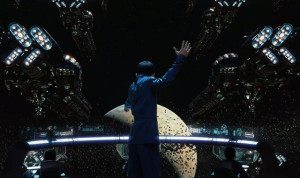 If you’re in the audience, though, then you are told a number of things and then told some contradictory things and then challenged to find something to think about — because we do not watch Ender’s Game and learn alongside Ender Wiggin. His mastery of Battle Room technique and strategy is presented like a dessert tray. Which sweet would you like? You shall have it.
If you’re in the audience, though, then you are told a number of things and then told some contradictory things and then challenged to find something to think about — because we do not watch Ender’s Game and learn alongside Ender Wiggin. His mastery of Battle Room technique and strategy is presented like a dessert tray. Which sweet would you like? You shall have it.
When he advances in his training to lead entire armies, his victory or defeat is just a spectacle because we do not care if he wins or loses. How can we? In the book, what is at stake is Ender’s soul. In the film, what is at stake is a war with some bug like aliens we’ve never met.
And then there is the grand reveal and you, like Ender, realize the lies you have been told. Unlike Ender, though, you have achieved or suffered nothing. Which could not be farther from the experience of watching 12 Years a Slave.
12 Years a Slave show and tell
There is no grand reveal in Steve McQueen’s 12 Years a Slave. Before you even buy your ticket — something you might seriously consider doing soon — you know how the film will end. Solomon Northrup, freeman of Saratoga, New York, circa 1841, after being enslaved for 12 years, will achieve his freedom.
Knowing this does not lessen the anguish of his slavery or the confusing shame of his eventual release. But I have mixed feelings about it.
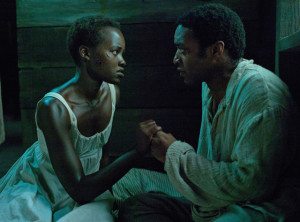 On the one hand, I felt as did the Supreme Being, that this film is powerful and beautiful and unsentimental. The acting is superb and McQueen is in fine form, composing lyrical scenes that cut a deep wake. On the other, it is a story that feels familiar. I see the period costumes, and watch the brutality, and feel myself disengage. Not because the subject matter is difficult but because I recognize what I see.
On the one hand, I felt as did the Supreme Being, that this film is powerful and beautiful and unsentimental. The acting is superb and McQueen is in fine form, composing lyrical scenes that cut a deep wake. On the other, it is a story that feels familiar. I see the period costumes, and watch the brutality, and feel myself disengage. Not because the subject matter is difficult but because I recognize what I see.
This is an unfair criticism of the film, but I cannot help my reactions to it. There are tropes to movies about slavery, whether they are artistically and thoughtfully made or whether they are exploitative and crass. As I recognize these tropes — struggling against one’s bonds; attempted flight; the genteel plantation owner contrasted with his inhuman treatment of slaves — I drift away.
As compared to McQueen’s first film, Hunger, 12 Years a Slave is clear and direct. It is not a gooey pile of self-congratulatory, Hollywood diaper filling, but it is a story many will not find surprising. When I’ve watched other films concerning slavery, I’ve imagined what McQueen evokes visually here. His film coheres to my imagination but does not engage it.
Are we surprised that slavery is monstrous? I hope not.
Watching this film, I get the opportunity to see through Steve McQueen’s (or Solomon Northrup’s) eyes — and I am moved — but they are not showing me something unexpected. In Hunger, deprived of dialogue and left mostly to my own imagination, I fill in the spacious gaps between what is depicted and what I understand motivates humans to behave in such extreme fashion. In 12 Years a Slave, Brad Pitt explains to Michael Fassbinder — and me — why slavery is unconscionable. I watch Solomon Northrup struggle when forced to whip his friend. It is a devastating scene, but because it is so clearly presented, I feel less engaged than if it were more oblique. I resist being told; I want to guess, as I did during the scene I mentioned earlier, with the horn and the mist.
Part of this reaction is surely due to my expectation. Having seen and loved Hunger, I wanted more of the same.
But then, to my great surprise, McQueen produces a grand reveal after all. At the end of the picture, when Solomon miraculously re-obtains his freedom, I weep, and attempt to watch the film again in my head all at once. There are words that Northrop says and emotions he conveys through the eyes of Chiwetel Ejiofor that I did not see coming.
With this one final scene, McQueen takes the characters of his film and places you inside them, into a place I had not known existed. A place beyond imagining. A place beyond simple depiction.
This is the crime of slavery. This is what it means to be human. This is art.
That much, at least, is clear.

